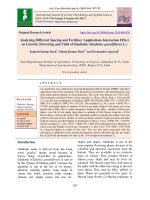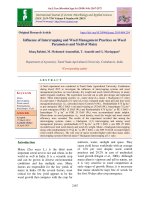Assessment of integrated nutrient on soil properties and yield of cowpea (Vigna unguiculata L.)
Bạn đang xem bản rút gọn của tài liệu. Xem và tải ngay bản đầy đủ của tài liệu tại đây (202.08 KB, 10 trang )
Int.J.Curr.Microbiol.App.Sci (2020) 9(8): 3484-3493
International Journal of Current Microbiology and Applied Sciences
ISSN: 2319-7706 Volume 9 Number 8 (2020)
Journal homepage:
Original Research Article
/>
Assessment of Integrated Nutrient on Soil Properties and
Yield of Cowpea (Vigna unguiculata L.)
Gavaskar*, Arun Alfred David, Tarence Thomas, Narendra Swaroop and Meraj Ahmed
Department of Soil Science and Agricultural Chemistry, Naini, Agricultural Institute,
Sam Higginbottom University of Agriculture, Technology and Sciences,
Prayagraj - 211 007, U. P., India, India
*Corresponding author
ABSTRACT
Keywords
Bio-fertilizers,
Vermicompost,
Rhizobium,
Integrated nutrient,
RDF, Cowpea,
Yield attributes,
Productivity, etc.
Article Info
Accepted:
26 July 2020
Available Online:
10 August 2020
The present investigation was carried out at research farm, department of
Soil Science and Agricultural Chemistry, Naini Agricultural Institute,
SHUATS, Prayagraj (U.P.) during the Kharif season of 2019 with the
objective to evaluate response of different levels of organic and inorganic
fertilizers on soil health, growth and yield attributes of cowpea [Vigna
unguiculata (L.)] Cv. Kashi Kanchan. The experiment was laid out in a
Randomized Block Design with nine treatment combinations, i.e. N2V2,
N1V2, N2V1, N1V1, N2R2, N1R2, N2R1, N1R1 and control. It was
observed that for post-harvest, treatment T9 (100 % RDF + 100 %
Rhizobium) was best in terms of growth, yield and economic parameters
with maximum plant height 64.40 cm, pods per plant 19.00, pod length
34.15, seeds per pod 10.67 and total yield 164.13 q ha-1. Treatment T9
(100 % RDF + 100 % Rhizobium) was best in terms of economic
parameters with maximum gross return of Rs. 1,64,130.00 and net profit
was Rs. 1,10,240.00 with benefit-cost ratio 1: 3.05.
Introduction
The advantage of combining organic and
inorganic sources of nutrients in integrated
nutrient management has been proved
superior to the use of each component
separately (Palaniappan and Annadurai,
2007). Rhizobium inoculation increased the
root nodulation through better root
development and more nutrient availability,
resulting in vigorous plant growth and dry
matter production which resulted in better
flowering, fruiting and pod formation and
ultimately there was beneficial effect on seed
3484
Int.J.Curr.Microbiol.App.Sci (2020) 9(8): 3484-3493
yield (Sardana et al., 2006). Vermicompost
has been emerging as an important source in
supplementing
chemical
fertilizer
in
agriculture
in
view
of
sustainable
development
after
Rio
Conference,
vermicompost is a bio-fertilizer enriched with
all beneficial soil microbes and also contains
all the essential plant nutrients like N, P and
K. Since vermicompost helps in enhancing
the activity of microorganisms in soil which
further increase solubility of nutrients and
their consequent availability to plants is
known to be altered by microorganism by
reducing soil pH at microsites, chelating
action of organic acids produced by them and
intraphyl mobility in the fungal filaments
(Parthasarathi et al., 2008). Nutrient
composition - Cowpea is loaded with various
types of nutrients. It is rich in fiber, protein,
iron, potassium, low in fat and calories. The
cup of cowpea possesses 11.1 g fiber, 13.22 g
protein, 35.5 g carbohydrate, 4.29 mg iron,
475 mg potassium, 0.91 g fat and 198
calories. Along with that, various amino acids
such as 0.612 g of tryptophan, 0.41 g of
histidine, 0.188 g of Methionine and 0.894 g
of lysine is contained in this seed. The per
capita availability of pulses in India is 35.5 g
per day as against the minimum requirement
of 70 g per day per capita as advocated by
Indian Council of Medical Research. It is,
therefore, imperative to increase the
productivity of pulse crops especially those of
minor importance (Anonymous, 2013-2014).
About Variety - This is dwarf and bush type
(height 50-60 cm), photo-insensitive, early
flowering (40-45 days after sowing) and early
picking
(50-55
days
after
sowing) variety suitable for growing in both
spring-summer and rainy seasons. Pods are
about 30-35 cm long, dark green, soft, fleshy
and free from parchment. The cultivar gives
green pod yield of about 150-175 q ha-1 and is
resistant to golden mosaic virus and
Pseudocercospora cruenta. This has been
released and notified during the XIII meeting
of Central Sub-Committee on Crop Standard
Notification and Release of Varieties for
Horticultural Crops for cultivation in U.P.,
Punjab, Bihar, Chhattisagarh, Orissa, A.P.,
M.P. and states. Area and Distribution Almost 33 m t of dry cowpea grains are
produced world over, of which Nigeria alone
produces 2.1 million ton, followed by Niger
(0.65 m t) and Mali (0.11 m t), making
Nigeria therefore, World's single largest
grower total global area of cowpea grown is
almost 13.0 m ha, of the same nearly 93 m ha
is grown in Africa only. In India cowpea is
grown in almost 1.3 m ha particularly in
Western, Central and penmsular regions in
some of Indian states including Maharashtra,
this crop is grown in all three seasons. The
total world acreage under pulses is about
85.40 (M ha) with production of 87.40 (Mt) at
1023 kg ha-1 yields level. India, with >29 M
ha pulses cultivation area, is the largest pulse
producing country in the world. It ranks first
in area and production with 34 per cent and
26 per cent respectively. During 2017-18 the
country's productivity at 835 kg ha-1, is a
significant increase over Eleventh (662 kg ha1
) and Twelfth plans (745 kg ha-1). In India,
total pulse area and production during 201718 has been >293 lakh hectares (L ha) and
245 lakh tonnes (L t) respectively. Out of the
total area, >73 Lakh ha is in Madhya Pradesh
alone, earning a prime status in pulse
production
commodity
registering
a
remarkable 25% of the country's pulse area
with 33% production, thereby ranking first
both in area and production. This is followed
by Rajasthan in respect of area (16 per cent)
and Maharashtra in case of total production
(13 per cent). Compared to normal
production, the estimated production during
2017-18 is 30% higher in case of total pulses,
32% gram, 27% arhar, 58% uradbean, 18%
mungbean and 40% higher lentil production.
More than 90 per cent of total pulse
production has been the contribution of 10
states namely, Madhya Pradesh, Maharashtra,
3485
Int.J.Curr.Microbiol.App.Sci (2020) 9(8): 3484-3493
Rajasthan, Uttar Pradesh, Karnataka, Andhra
Pradesh, Gujarat, Jharkhand, Tamil Nadu and
Telangana.
treatments were recorded at 50 days of crop
maturity. For this, five plants were randomly
selected from each plot and tagged for
observation to be recorded.
Material and Methods
Post - harvest observations
The experiment was conducted at the crop
Research farm of the Soil Science and
Agricultural Chemistry, Sam Higginbottom
University of Agriculture, Technology and
Sciences, Prayagraj, U.P. which is located on
the south of the Prayagraj city. It is situated at
250o SW, 25024’23’’N latitude and 81°
50’38’’ E longitude and 98 m above the mean
sea level. One control and eight nutrient
management practices were used as a
treatment with 3x3 Randomized block design
having three different factors with level of N
P K @ 50 and 100 % kg ha-1, Level of
Rhizobium @ 50 and 100 % ha-1, level of
vermicompost @ 50 and 100 % ha-1
respectively. At the first amount of nutrient
and N P K supplied by Rhizobium,
Vermicompost, Urea, SSP and MOP
respectively (Table 1 and 2). Scraping the
crust of soils following by weeding was done
three times at 20, 40 and 60 days after
sowing. Irrigation was done as required by
crop after sowing. Five plants were tagged
from each plot for recording data. Row to row
distance was maintained at 30 cm and plant to
plant distance was 10 cm, at the depth of 5 cm
during the course of experiment, observations
were recorded as mean values of the data.
Pod Length (cm) - Length of pod under
different treatments was recorded at maturity
of crop. For this, five plants were randomly
selected from each plot and tagged for
observation to be recorded. Length of pod in
centimeter recorded from shoot tip to end
point of pod. No. of seeds per pod - No. of
seeds per pod under different treatments was
recorded at crop maturity. For this, five plants
were randomly selected from each plot and
tagged for observation to be recorded. Pod
yield (q ha-1) - The pod yield from the net plot
area was recorded in kg plot-1 and figure
converted into q ha-1.
Dose of fertilizer
1) 100% NPK = (100% N:P:K =20:60:40
kg)
2) 50% NPK = (50% N:P:K =10:30:20
kg)
3) 100% Rhizobium = 20 g kg-1 seed
Rhizobium
4) 50% Rhizobium = 10 g kg-1 seed
Rhizobium
5) 100% Vermicompost = 2 q ha-1
Vermicompost
6) 50% Vermicompost = 1 q ha-1
Vermicompost
Pre- harvest observations
Plant height (cm) - Height of crop plants
under different treatments was recorded at 20,
35 and 50 days interval. For this, five plants
were randomly selected from each plot and
tagged for observation to be recorded. Height
of plants in cm. recorded from ground level
up to the base of the last fully opened leaf of
the main shoot. No. of pods per plant - Total
no. of pods per plant under different
The tables show the interaction effects of N P
K, Rhizobium, and Vermicompost are
generally influenced growth and yield of
cowpea. The statistically analyzed data
presented in tables 3–7. The result of the data
shows that plant height, no. of pod per plant,
length of pod, no. of seed per pod, yield of
cowpea. From the data presented in the
treatment combination T9 - (100 % RDF+20 g
3486
Int.J.Curr.Microbiol.App.Sci (2020) 9(8): 3484-3493
kg-1 seed Rhizobium) was recorded maximum
64.40 cm plant height at 50 DAS. While it
was recorded at par 43.63 cm at 50 DAS in
treatment combination T1 - (Control). This
may be due to application of major and minor
nutrients, through different levels of organic
manure and chemical fertilizers, increased the
photosynthetic
activity,
chlorophyll
formation, nitrogen metabolism and auxin
contents in the plants which ultimately
improving the plant height and no. of
branches per plant.
Plant height:
The data presented in table 3 clearly shows
the response of plant height of pea recorded at
20 DAS, 35 DAS and 50 DAS as influenced
by different levels of N P K, Rhizobium and
vermicompost. The plant height of cowpea
was found to be increased significantly with
the increase in levels of N P K, Rhizobium
and vermicompost. The maximum plant
height was recorded as 24.49 cm, 34.38 cm
and 64.40 cm in T9 (100 % RDF + 100 %
Rhizobium) at 20 DAS, 35 DAS and 50 DAS
respectively and the plant height was recorded
at par 10.30 cm, 18.63 cm and 43.63 cm in T1
(control) at 20 DAS, 35 DAS and 50 DAS
respectively. Increase in plant height due to
increase in N P K, Rhizobium and
vermicompost may be due to adequate supply
of nutrients which in turn helps in vigorous
vegetative growth of plants and subsequently
increase the plant through cell elongation, cell
division, photosynthesis and turbidity of plant
cell. The increase in nodulation and nitrogen
fixation leads to more plant height. Similar
findings were reported by Ashwani et al.,
(2016), Yadav et al., (2017), Abdel et al.,
(2012) and Maurya et al., (2017).
Table.1 Details of treatment of cowpea
Treatment
Dosage ha-1 in percentage
Symbol
Level of N, P & K
100% NPK as SSP and MOP
N1
50% NPK as SSP and MOP
N2
100% Rhizobium
R1
50% Rhizobium
R2
100% Vermicompost
V1
50% Vermicompost
V2
Level of Rhizobium
Level of Vermicompost
3487
Int.J.Curr.Microbiol.App.Sci (2020) 9(8): 3484-3493
Table.2 Treatment combination of cowpea
Symbol
Treatment Combination
(T1= Control)
(Control)
(T2=N2 + V2)
(@ 50 % RDF + 1 q ha-1 Vermicompost)
(T3=N1 + V2)
(@ 100 % RDF + 1 q ha-1 Vermicompost)
(T4=N2 + V1)
(@ 50 % RDF + 2 q ha-1 Vermicompost)
(T5=N1 + V1)
(@ 100 % RDF + 2 q ha-1 Vermicompost)
(T6= N2+ R2)
(@ 50 % RDF + 10 g kg-1 seed Rhizobium)
(T7= N1+ R2)
(@ 100 % RDF + 10 g kg-1 seed Rhizobium)
(T8= N2+ R1)
(@ 50 % RDF + 20 g kg-1 seed Rhizobium)
(T9= N1+ R1)
(@ 100 % RDF + 20 g kg-1 seed Rhizobium)
Table.3 Effect of different levels of N P K, Rhizobium and vermicompost on the Plant height
(cm) 20, 35 and 50 DAS of Cowpea
Plant height (cm)
Treatment
T1
20 DAS
10.30
T2
11.16
21.17
45.37
T3
13.37
23.38
47.79
T4
14.73
24.73
51.19
T5
16.37
26.37
53.71
T6
18.77
28.80
55.78
T7
20.53
30.56
58.07
T8
22.22
33.22
61.19
T9
24.49
34.38
64.40
F-test
S
0.31
S
0.32
S
0.28
0.67
0.69
0.58
SE. d (±)
C.D. (P= 0.05)
35 DAS
18.63
3488
50 DAS
43.63
Int.J.Curr.Microbiol.App.Sci (2020) 9(8): 3484-3493
Table.4 Effect of different levels of N P K, Rhizobium and vermicompost on the number of
pods-1 plant at 50 DAS of Cowpea
Treatment
T1
T2
T3
T4
T5
T6
T7
T8
T9
F-test
SE. d (±)
C.D. (P= 0.05)
Number of pods-1 plant
9.33
10.42
12.00
13.30
14.47
15.53
16.70
17.80
19.00
S
0.12
0.26
Table.5 Effect of different level of N P K, Rhizobium and vermicompost on the pod length of
Cowpea
Treatment
T1
T2
T3
T4
T5
T6
T7
T8
T9
F-test
SE. d (±)
C.D. (P= 0.05)
Pod length (cm)
14.01
18.71
23.87
19.97
21.80
26.77
21.70
27.67
34.15
S
1.06
2.25
3489
Int.J.Curr.Microbiol.App.Sci (2020) 9(8): 3484-3493
Table.6 Effect of different level of N P K, Rhizobium and vermicompost
on the seeds pod-1 of cowpea
Treatment
Seeds per pod
T1
6.00
T2
6.67
T3
7.67
T4
6.67
T5
8.67
T6
9.67
T7
7.67
T8
10.00
T9
10.67
F-test
S
SE. d (±)
0.84
C.D. (P= 0.05)
1.77
Table.7 Effect of different level of N P K, Rhizobium and vermicompost on the yield of Cowpea
Treatment
T1
yield (q ha-1)
132.33
T2
146.00
T3
153.33
T4
138.33
T5
144.17
T6
154.20
T7
156.27
T8
159.07
T9
164.13
S
1.32
2.80
F-test
SE. d (±)
C.D. (P= 0.05)
3490
Int.J.Curr.Microbiol.App.Sci (2020) 9(8): 3484-3493
Pods per plant
The data presented clearly shows the response
of pods per plant of cowpea recorded at 50
DAS as influenced by different levels N P K,
Rhizobium and vermicompost. The number of
pods per plant of cowpea was found to be
increased significantly with the increase in
levels of N P K, Rhizobium and
vermicompost. The maximum number of
pods was recorded as 19.00 in T9 (100 %
RDF+ 100 % Rhizobium) at 50 DAS and the
number of leaves were recorded at par 9.33 in
T1 (control) at 50 DAS. Increase in number of
pods may be due to adequate nutrients supply
which enhanced the vegetative growth of
plant and subsequently the number of pods.
Similar findings were reported by Ashwani et
al., (2016), Yadav et al., (2017), Abdel et al.,
(2012) and Maurya et al., (2017).
Pod length
The data presented clearly shows the response
of pod length of cowpea recorded as
influenced by different levels N P K,
Rhizobium and vermicompost. The pod length
per plant of cowpea was found to be increased
significantly with the increase in levels of N P
K, Rhizobium and vermicompost. The
maximum pod length was recorded as 34.15
in T9 (100 % RDF+ 100 % Rhizobium) and
the pod length was recorded at par 14.01 in T1
(control). Increased in pod length may be due
to adequate availability of nutrients during
reproductive stage of crop results in the
increased pod length. Similar results were
also reported by Ashwani et al., (2016),
Yadav et al., (2017), Abdel et al., (2012) and
Maurya et al., (2017).
Seeds per pod
The data presented clearly shows the response
of seeds per pod of cowpea recorded as
influenced by different levels N P K,
Rhizobium and vermicompost. The number of
seeds per pods of cowpea was found to be
increased significantly with the increase in
levels of N P K, Rhizobium and
vermicompost. The maximum number of
seeds per pods was recorded as 10.67 in T9
(100 % RDF+ 100 % Rhizobium) and the
number of seeds per pods were recorded at
par 6.00 in T1 (control). Increase in number of
seeds per pod may be due to adequate
availability of nutrients during reproductive
stage of crop results in the formation of more
seeds. Similar results were also reported by
Ashwani et al., (2016), Yadav et al., (2017),
Abdel et al., (2012) and Maurya et al., (2017).
Pod yield
The data presented clearly shows the response
of pod yield of cowpea recorded as influenced
by different levels N P K, Rhizobium and
vermicompost. The pod yield of cowpea was
found to be increased significantly with the
increase in levels of N P K, Rhizobium and
vermicompost. The maximum pod yield was
recorded as 164.13 in T9 (100 % RDF+ 100 %
Rhizobium) and the pod yield was recorded at
par 132.33 in T1 (control). Increase in pod
yield may be due to adequate availability of
nutrients during reproductive stage of crop
results in the formation of more pods. Similar
results were also reported by Ashwani et al.,
(2016), Yadav et al., (2017), Abdel et al.,
(2012) and Maurya et al., (2017)
Summary
Application of 100 % RDF+20 g kg-1
significantly enhanced the plant height and
number of branches per plant at harvest.
Significantly higher number of pods per plant
number of seed per pod, seed, straw and
biological yield. Each successive dose of N P
K, Rhizobium and Vermicompost, resulted in
a significant increase in all growth parameters
i.e. plant height, number of leaves, number of
3491
Int.J.Curr.Microbiol.App.Sci (2020) 9(8): 3484-3493
branches and dry mater accumulation.
Maximum
growth
and
dry
matter
accumulation was recorded at N20 P60 K40
applied as Urea, SSP and MOP + 20 g kg-1
seed Rhizobium. Interactive effect of biofertilizer and fertility levels significantly
influenced seed yields, N and P uptake by
seed and net returns and maximum being with
100 % RDF+20 g kg-1 seed Rhizobium.
Application of 100 % RDF+20 g kg-1 seed
Rhizobium significantly increased the organic
carbon, available N, P2O5 and K2O content
in soil. But the maximum available N, P, K
and O.C. % in soil was recorded at N20 P60
K40 + 20 g kg-1 seed Rhizobium. Maximum
net return by seed and straw yield was
obtained significantly with Rhizobium + N20
P40 K60.
Conclusion
The highest seed yield and plant growth is
obtained from T9= N1+ R1 (@ 100 % RDF
+20 g kg-1 seed Rhizobium) treatment. It is
also found that Rhizobium and Vermicompost
are effectively gave good result comparison to
other treatment and control treatment. The
treatment T9f=N1+R1 showed a highest
benefit-cost ratio followed by T8= (N2+R1)
other treatments so use of Rhizobium and
vermicompost is the recommended to the
farmers and use of bio-fertilizers like
Rhizobium and manures like vermicompost
should be increase.
Acknowledgement
The author is thankful to Hon’ble Vicechancellor, HOD, Advisor and non-teaching
staff of Department of Soil Science and
Agricultural Chemistry, Sam Higginbottom
University Agriculture, Technology and
Sciences, Prayagraj, U.P. for providing all
facilities to clarify my studies.
References
AbdeI-SaIam, M. A. and Salem, H. M. (2012).
Interaction Between Potassium and Organic
Manure Application on Growth of Cowpea
(Vigna unguiculata L.) and soil properties
in newly reclaimed sandy soil. World
Journal of Agricultural Sciences, 8 (2):
141-149.
Ashwani, K. and Pandita, V. K. (2016). Effect of
integrated nutrient management on seed
yield and quality in cowpea. Legume
Research - An International Journal, 39
(3): 448-452.
Chauhan, D.K., Umrao, R., Bijalwan, A., (2016).
Effect of NPK levels in combination with
Rhizobium and PSB culture on growth and
yield of greengram (Vigna radiata L.
Wilczek) under Subabul (Leucaena
leucocephala) based agro-forestry systems.
Int. J. Curr. Res. Biosci. Plant Biol.,3 (2):
54-57.
Khajuria, S, Thomas, T. and Kumar, V. (2014).
Effect of biofertilizer and different sources
of phosphatic fertilizers in soil properties,
nutrient uptake and yield of field pea
(Pisum sativum L.) in alluvial soil.
Environment and Ecology, 32 (4) 17201724.
Maurya, S. K., Gupta, S., Singh, D. P. and Kasera,
S. (2017). Effect of integrated nutrient
management on growth and yield attributes
of table pea (Pisum sativum L.) cv. AP-3.
International Journal of Chemical Studies;
5 (6): 906-908.
Panda S.C. (2012) Handbook of agriculture; 310321.
Panda, R. R., Sahu, G. S., Dash, S. R., Muduli, K.
C., Nahak, S., Pradhan, S. R. and Mangaraj,
S. (2017). Integrated nutrient management
for seed production in cowpea [Vigna
unguiculata L.], Journal of Pharmacognosy
and Phytochemistry, 6 (5): 1845-1849.
Singh, B. and Pareek, R.G. 2003. Effect of
phosphorus and bio-fertilizers on growth
and yield of mungbean. Indian Journal of
Pulses Research, 16: 31-33.
Singh, H. and Reddy, M.S. 2011. Efficiency of
inoculation with phosphate solubilizing
fungus on growth and nutrient uptake of
wheat and maize plants fertilized with rock
3492
Int.J.Curr.Microbiol.App.Sci (2020) 9(8): 3484-3493
phosphate in alkaline soils. European
Journal of Soil Biology, 47: 30-34.
Singh, S. and Kapoor, K.K. 1992. Effect of
inoculation of phosphorus solubilizing
micro- organisms and an arboscular
mycorrhizal fungus on mungbean grown
under natural soil conditions Mycorhiza, 7:
249-253.
Singh, S.R., Bhat, M.L., Wani, J.A. and Najar,
G.R. 2009. Role of Rhizobium and VAM
fungi for improvement in fertility and yield
of green gram under temperate conditions.
Journal of the Indian Society of Soil
Science, 57: 45-52.
Snell, F.D. and Snell, C.T. 1949. Calorimetric
Methods of Analysis, Third Edn. Vol, II D.
Van Nostrand Co. Inc., New York. Soil
Survey Staff, 1975. Soil Taxonomy.
Agriculture Hand Book No. 16
Subbiah, B.V. and Asija, G.L. 1956. A rapid
procedure for the determination of available
nitrogen in soils. Current Science, 25: 259260.
Thenua, O.V.S., Singh, S.P. and Shivakumar, B.
G. 2010. Productivity and economic of
chickpea (Cicer arietinum) fodder sorghum
(Sorghum bicolour) cropping system as
influenced by P sources, bio-fertilizer to
chickpea. Indian Journal of Agronomy,
55:22-27.
Tilak, K.V.B.R and Annapurna, K. 1993. Effect of
PSB in different crop. India National
Academic Science, 59: 315-324.
Tiwari, D. and Kumar, K. 2009. Effect of biofertilizer and phosphorus levels on growth,
nodulation and yield of mungbean. (In)
International Conference on Grain Legumes
: Quality Improvement, Value Addition and
Trade held during 14-16 February, 2009 at
Indian Institute of Pulses Research, Kanpur.
Umale, S.M., Thosar, V.R., Chorey, A.B. and
Chimate, A.N. 2002. Growth response of
soybean to P solubilizing bacteria and
phosphorus level. Journal of Soils and
Crops, 12: 258-261.
USDA : 436. Srinivasa Reddy, K. and Uma
Mahesh, P. 1995. Proceedings of National
Seminar on Development of Soil Science,
pp. 114.
Vaisya, V.K.; Gayendregdkar, G.R. and Penday,
R.L. 1983. Effect of Rhizobium inoculation
on nodulation and grain yield of mungbean.
Indian Journal of Microbiology, 23: 228230.
Vasanthi, D. and Kumarswamy, K. 1999. Effect
of continuous cropping and fertilization on
chemical properties of soil. Journal of the
Indian Society of Soil Science, 37: 171-173.
Vasanthi, D. and Subramanian, S. 2004. Effect of
vermicompost on nutrient uptake and
protein content in blackgram. Legume
Research, 27: 293-295.
Vikram, A. and Hamzehzarghani, H. 2008. Effect
of phosphate solubilizing bacteria on
nodulation and growth parameters of
greengram (Vigna radiata L. Wilczek).
Research Journal of Microbiology, 3: 6272.
Wakley, A. and Black, I. A. (1947) Critical
examination of rapid method for
determining organic carbon in soils, effect
of variance in digestion conditions and of
inorganic
soil
constituents.
Soil
science.632:251.
Yadav, A. K., Naleeni, R. and Singh D. (2017).
Effect of organic manures and biofertilizers
on
growth
and
yield,
International Journal of Chemical Studies,
5 (6): 906-908.
How to cite this article:
Gavaskar, Arun Alfred David, Tarence Thomas and Narendra Swaroop and Meraj Ahmed.
2020. Assessment of Integrated Nutrient on Soil Properties and Yield of Cowpea (Vigna
unguiculata L.). Int.J.Curr.Microbiol.App.Sci. 9(08): 3484-3493.
doi: />
3493
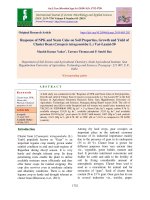
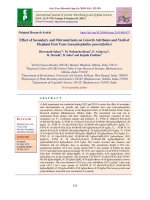
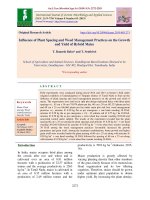
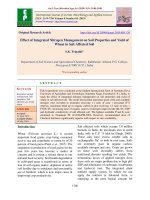
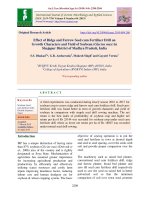
![Effect of fertility levels and stress mitigating chemicals on nutrient uptake, yield and quality of mungbean [Vigna radiata (L.) Wilczek] under loamy sand soil of Rajasthan](https://media.store123doc.com/images/document/2020_01/09/medium_ftp1578562755.jpg)

